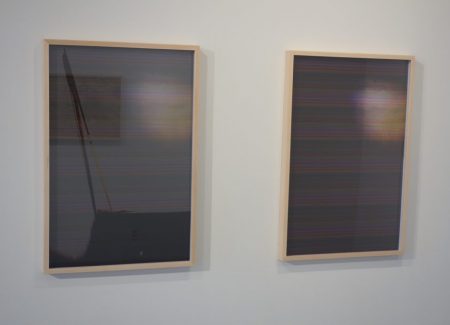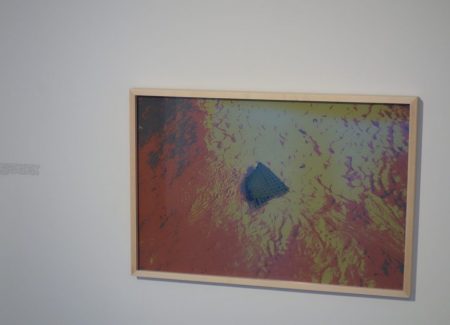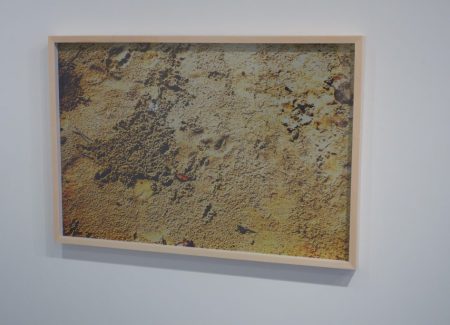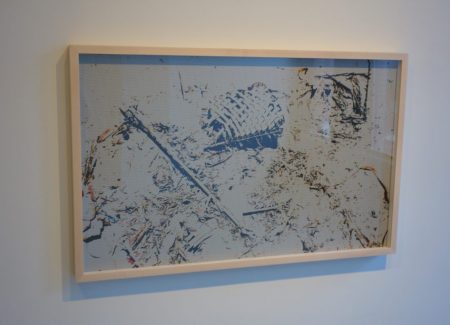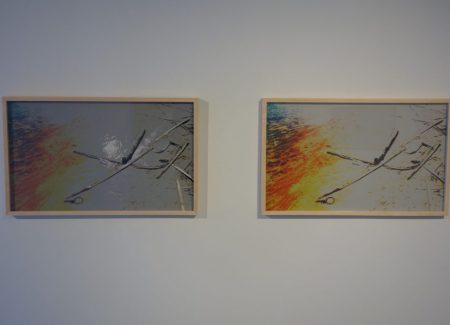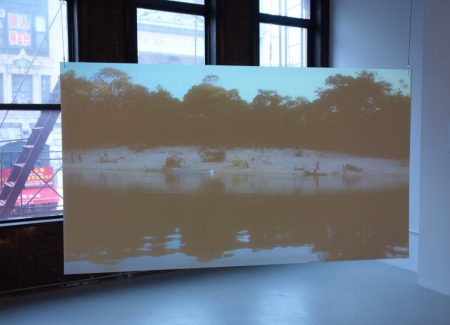JTF (just the facts): A total of 7 photographic works (4 single images and 3 diptychs), framed in blond wood and unmatted, and hung against white walls in the single room gallery space. All of the works are ink jet prints of digital images encoded with the title at 6 or 7 bits per byte, made in 2017. Each image/panel is sized roughly 36×24 (or reverse) and each of the works is available in an edition of 3+1AP. The show also includes 1 single projection video with sound, 9:50 minutes, made in 2017, and dry transfer wall texts. (Installation shots below.)
Comments/Context: One of the main technical byproducts of the digital revolution in photography has been the conversion of imagery into arrays of pixels made up of bits and bytes. Not only has this digitization made exact reproduction effectively infinite, it has enabled software algorithms to become deliberate agents of change. Now when we decide to use a “filter” on a smartphone image, allowing us to transform the color into monochrome, or “faded”, or sepia-toned versions, we are using lines of software code to actively and systematically transform the underlying pixels.
By applying filters to our photographs, in most cases, we are trying to “improve” their ability to communicate what we want, and it is our assumption that our choices will somehow increase the “effectiveness” of the imagery. When we step back from this line of thinking, it becomes immediately clear that depending on one’s perspective and how software is employed, all kinds of artistic outcomes might emerge from such an intentional process of transformation, and not all of them would necessarily generate the “enhanced” end results we might have expected or desired.
Julien Bismuth dives into the deep end of this conceptual pool with his recent photographs and video. As an artist, Bismuth is interested in the underlying patterns embedded in visual communication (and their parallels in the world of language/linguistics), and his new works explore the edges of what representation is and means, especially when subject to different forms of translation.
The back story to Bismuth’s pictures brings together an elaborate (and some might say unlikely) journey into the uncertainty of communication. Working with the anthropologist Marco Antonio Gonçalves, Bismuth traveled to the jungles of Brazil, ultimately spending time with the Pirahã, an indigenous people from the Amazon. What is particularly intriguing about the Pirahã is that they have neither a system of writing nor a tradition of image making – their communication is based on a language of tones that can be hummed, whistled, and even muttered.
Bismuth’s photographs capture various found details from his trip – the lush banks of the river, a wooden canoe, sandy strips of beach, a discarded basket and bowl, flies, and other textural fragments of the detritus of the river – and on their own, these pictures would not be hugely memorable. But he then subjects these images to an intricate series of transformations that make their representative function much more uncertain. Using the words in the titles of the photographs as his key, Bismuth has encoded the text directly into the images, using custom software to encrypt the bits within each individual pixel – the more bits he encodes, the more the color data is altered and the more the image starts to dissolve. When he’s finished, the results mimic the feeling of communication that is full of tiny gaps and fragile misunderstandings, a “hesitation” as he calls it.
As Bismuth works through his iterations, each object incrementally breaks down, moving from something representative, to an ephemeral impression, to a degraded echo, to elemental digital noise in successive steps. This is particularly visible in the diptychs, which show the same image in two stages of encryption. Colors and textures wander from their original states, becoming abstract swaths reminiscent of sunsets or flares of light, only to expose themselves as rigidly mechanized stripes and patterns in their final stage of stripping away. On the surface, they communicate less and less, and yet, this is perhaps the telling metaphorical point – as they are further transformed by the encrypted text, they communicate something more open to interpretation, which leads us to thornier questions about what seeing is exactly and how much information we really need to make sense of an image.
While the intricacies of Bismuth’s clever process can at some points feel a bit mannered, the best of his images seem to float in the borderlands between clarity and illusion, where fleeting recognition occurs and then dissolves into the ether. There is gentle beauty to be found in many of these digital surfaces, especially in the beaches that take shape amid pinks and baby blues or yellows and smoldering reds and then break down once again, constantly oscillating between resolution and abstract iridescence. Like a language that we can’t quite understand, Bismuth’s photographs give us hints to their intent, but leave us wondering as they gracefully slip through our fingers and dissipate into thin air.
Collector’s POV: The photographs in this show are priced at $7000 (for the singe images) and $10000 (for the diptychs). Bismuth’ work has little secondary market history, so gallery retail remains the best option for those collectors interested in following up.
